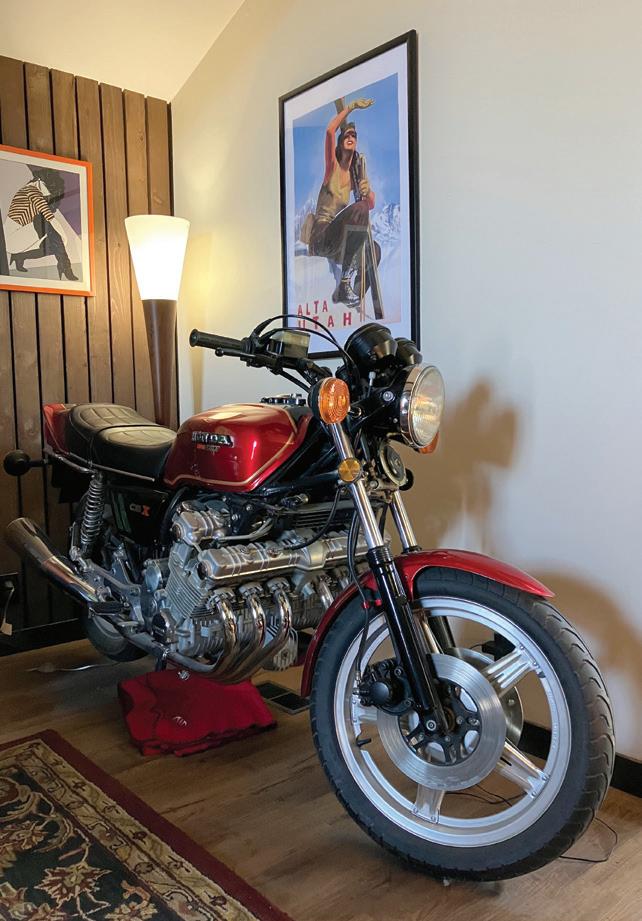
3 minute read
PERSPECTIVES
PERSPECTIVES HITS ’N’ MISSES, AND A LIVIN’-ROOM MISSUS
BY MITCH BOEHM
While watching football this past weekend from the comfort of my couch, I glanced to my right and took in the full measure of the 1979 Honda CBX I have parked against the wall in my living room — about three feet away. It’s the Candy Glory Red version with a two-digit VIN, the impossible-to-get sport kit bars and controls, and very few miles on the clock after a restoration from the “CBXperts” at TIMS CBX in the early 2000s.
I have bought and sold five or six of these six-cylinder works of twowheeled art over the years, and while I’ve scaled down my collection of late, I couldn’t bear to part with this one. So there it sits, looking Empress-like and fulfilling my dream of displaying a legendary motorcycle or two in my house (there might be an XR75 somewhere else), but probably hoping to get back on the road at some point. We talk about it occasionally when no one’s around.
lasted only two years, ’79 and ’80 (the ’81 and ’82 versions are totally different motorcycles, and they didn’t last, either), but it’s reached legend status since then. Its linkage with Honda’s five- and six-cylinder GP bikes and Honda engineer Shoichiro Irimajiri, who designed all of them, certainly has a lot to do with it, but even more than that is the CBX’s jaw-dropping beauty and pure sex appeal. Those spindly fork legs, wooden brakes and the lack of a proper frame make it a bit of a nightmare at speed, but none of that matters. The CBX is awesome in look, sound and, back then, at least, straight-line performance. A few of the latter that came to mind were Suzuki’s early-’80s V4-engined Madura, which was designed to (hopefully) compete with Honda’s popular and powerful Magna models; Cagiva’s Pantah-engined Ducati Indiana of the late ’80, which was the answer to a question no one asked — though it may qualify for Ahead Of Speaking of Honda, it built a load of bikes in the late 1980s that fit pretty nicely in the aforementioned “Ahead Of Its Time” category...

Of course, as I took in the CBX’s billboard-sized cylinder bank, 35mm fork tubes (who decided that?), Comstar wheels and pristine paint, I flashed on the Suzuki RE-5 I’d just written about for this issue, and then began to consider a whole range of functionally-decent motorcycles that never, for whatever reason, managed to gain acceptance in the U.S. market.
And there’s some irony there, as some of these failures are remembered fondly (and are even legendary), while others are mostly forgotten.
The Six is a good example of the former. Like the RE-5, the first-gen CBX Its Time honors; Kawasaki’s late ’80s Voyager big-rig, which was up against a little-known bike called the Gold Wing. The list goes on and on.
Speaking of Honda, it built a load of bikes in the late 1980s that fit pretty nicely in the aforementioned Ahead Of Its Time category. The very cool — and very naked — 400cc CB-1 is a perfect example; Honda couldn’t give the things away, and ended up selling most of them back to Honda Europe, which had plenty of interested buyers. The GB500 is another; try finding one on the cheap today and you’ll know. The Pacific Coast bombed at first,

Mid-Century Modern meets 24 valves and six cylinders… gotta love it.
and then made a comeback once folks realized how truly functional it was despite its vanilla styling.
And then there was the Transalp, another highly competent short-timer that went away far too quickly and for far too long. Shame on U.S. buyers for not understanding and recognizing these very cool and very good Hondas at the time, but on the other hand, I cannot fathom why it took three decades to reintroduce the Transalp to the U.S. market given the state of adventure touring here. Ditto the Africa Twin.
But hey, that’s just armchair quarterbacking from an ex-Honda product-planning guy. Still, I gotta admit: Remembering and writing about all these wonderful bikes is damn fun… especially when there’s a perfect example three feet away.
Mitch Boehm is the Editorial Director of the AMA






